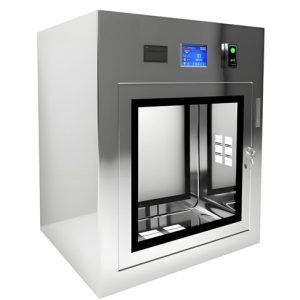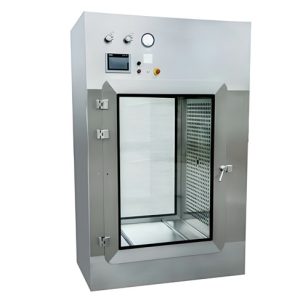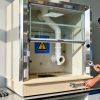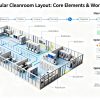Account
-
Safe payment options
We only work with the most secure payment systems.
-
Product return within 30 days
We do our very best to keep our customers happy.
No products in the cart.
You dont have any products in your cart yet, add a few products to experience this experience.
Add $500.00 to cart and get free shipping!
To see and take advantage of all discounted products.
Click HereModular Cleanroom Doors & Windows — Essential 7‑Point Specifications, Selection & Quick Installation Guide
Introduction
Example: A pharmaceutical facility requiring ISO 5 classification must ensure their modular cleanroom doors maintain ≤0.1 L/s·m² leakage at 100 Pa pressure differential, while modular cleanroom windows need anti-fog coatings to maintain visibility during sterilization cycles.
Hinged Doors
✓ Manual operation
✓ Cost-effective
✓ Simple maintenance
Sliding Doors
✓ Space-saving
✓ Automatic options
✓ High traffic areas
Hermetic Doors
✓ Maximum sealing
✓ Sterile applications
✓ Critical environments
Pass-through Windows
✓ Material transfer
✓ Interlock systems
✓ Contamination control
Door & Window Types Overview
The selection of appropriate modular cleanroom doors and modular cleanroom windows depends on application requirements, traffic patterns, and cleanliness classification. Proper specification ensures optimal performance and compliance with industry standards.
Understanding the different cleanroom window types available helps designers create efficient layouts that support both operational workflow and contamination control protocols.
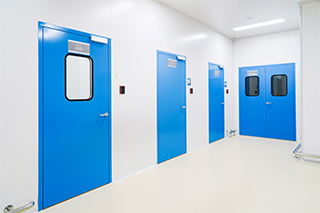
Modular Cleanroom Doors
Hardwall Hinged Doors
Single-leaf (900mm width) and double-leaf (1500-1800mm width) configurations. Stainless steel 304 frames with vision panels. Typical applications: personnel access in ISO 7-8 areas. Air leakage: ≤1.0 L/s·m² @ 50 Pa. Deiiang™ hinged doors feature reinforced frames capable of withstanding 500,000 operational cycles.
Sliding Doors
Automatic (0.8-1.2 m/s opening speed) and manual variants. Trackless systems preferred for minimal particulate generation. Example: Deiiang™ automatic cleanroom door systems feature brushless DC motors with 500,000 cycle MTBF and leakage rates of ≤0.8 L/s·m² @ 50 Pa.
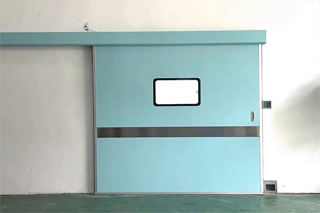
Modular Cleanroom Sliding Doors
Hermetic/Air-Tight Doors
Critical for sterile applications and isolator interfaces. Inflatable silicone seals achieving ≤0.1 L/s·m² @ 100 Pa. Typical thickness: 60mm with stainless steel 316L construction. Applications: ISO 5-6 areas requiring maximum contamination control. A proper hermetic cleanroom door maintains pressure differentials even during frequent operations.
Pass-Through / Transfer Windows
Alcove and pass-box configurations with mechanical or electronic interlocks. Standard sizes: 400×400mm to 600×800mm. UV interlock options available for decontamination cycles. Deiiang™ pass-through window cleanroom systems feature seamless stainless steel construction and cascade interlock sequences.
Observation/Inspection Windows
Double-paned tempered glass (8+8mm) with anti-fog coating. Maximum size: 1200×1800mm without structural reinforcement. Flush mounting with minimal 3mm reveal for cleanability. Light transmission: ≥92% for optimal visibility. These specialized cleanroom window types provide critical visibility while maintaining environmental integrity.
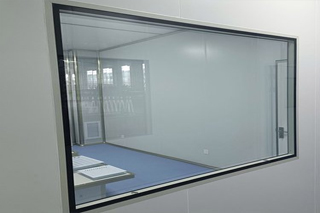
Modular Cleanroom windows
Key Specification Parameters
Engineering checklist for specifying modular cleanroom doors and modular cleanroom windows must include material compatibility, performance metrics, and integration requirements. These parameters form the foundation of effective cleanroom doors specifications.
Comprehensive cleanroom doors specifications ensure that all components work together to maintain the required cleanliness levels while supporting operational efficiency.
Material Selection Guide
Stainless Steel 304: General applications, Ra ≤0.8 μm
Stainless Steel 316L: Chemical resistance, pharmaceutical
Powder-Coated Steel: Cost-effective, non-critical areas
Tempered Glass: Visibility areas, safety requirement
Performance Metrics
Air Leakage: ≤0.5 L/s·m² @ 50 Pa
Cycle Life: 500,000 operations minimum
Surface Finish: Ra ≤0.8 μm for cleanability
Thermal Insulation: U-value 1.1-1.8 W/m²K
Airtightness Calculations
Leakage rate calculation formula: Q = (V × ΔP) / (t × A) where:
Q = Leakage rate (L/s·m²)
V = Volume (m³)
ΔP = Pressure difference (Pa)
t = Time (s)
A = Door area (m²)
Example Calculation: For a 2.1m² door maintaining 25 Pa pressure differential with 0.5 m³ volume loss over 60 seconds:
Q = (0.5 × 25) / (60 × 2.1) = 0.099 L/s·m² – This meets ISO 5 requirements.
Performance & Test Criteria
Validation of modular cleanroom doors and modular cleanroom windows requires rigorous testing protocols documented in IQ/OQ packages. These criteria ensure reliable performance in critical environments.
Proper testing of both modular cleanroom doors and modular cleanroom windows is essential for maintaining ISO 14644 compliance and ensuring long-term operational reliability in controlled environments.
| Test Type | Standard | Acceptance Criteria | Frequency |
|---|---|---|---|
| Air Leakage | EN 12207 | ≤0.5 L/s·m² @ 50 Pa | Quarterly |
| Cycle Testing | ISO 15821 | 100,000 cycles | Annually |
| Cleanability | USP <797> | ≤1 CFU/25 cm² | Monthly |
Sizing, Clearances & Layout Considerations
Proper dimensional planning ensures efficient operation of modular cleanroom doors and optimal placement of modular cleanroom windows. These considerations impact workflow efficiency and contamination control.
The strategic placement of modular cleanroom doors and modular cleanroom windows directly influences personnel flow, material transfer efficiency, and overall cleanroom performance.
Standard Dimension Guide
Personnel Doors:
900×2100mm
Clear opening: 800×2000mm
Equipment Doors:
1200×2400mm
Clear opening: 1100×2300mm
Pass-through Windows:
500×500mm to 800×800mm
Material transfer only
Clearance Calculation Example: For a sliding door system, required wall space = Door width + (2 × frame thickness) + operational tolerance. For a 900mm door: 900 + (2 × 50) + 25 = 1025mm minimum.
Integration with Control & Interlock Systems
Modern modular cleanroom doors require sophisticated control systems to maintain contamination control protocols. Proper integration ensures seamless operation and compliance with regulatory requirements.
Advanced control systems for modular cleanroom doors and modular cleanroom windows provide the intelligence needed to maintain cleanroom integrity while optimizing operational efficiency.
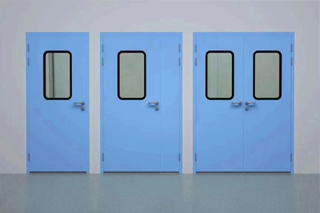
Interlock Sequence Timing: Cascade interlock systems typically use 5-15 second purge cycles. Calculation: Required purge time = (Room volume × Air changes) / HVAC capacity. Example: 50m³ room with 20 ACH and 1000 m³/hr HVAC = (50 × 20) / (1000/3600) = 3.6 seconds minimum purge time.
Sensor Integration Specifications
Deiiang™ control systems feature:
• Safety light curtains: Type 4, IEC 61496 compliant
• Response time: ≤80 ms for personnel protection
• Traffic sensors: 5-10m range, adjustable sensitivity
• Data logging: 50,000+ events, 21 CFR Part 11 compliant
Installation & Interface Details
Proper installation of cleanroom windows and cleanroom doors is critical for long-term performance and compliance. Attention to interface details prevents contamination risks and ensures structural integrity.
The installation quality of modular cleanroom doors and modular cleanroom windows directly impacts their ability to maintain the required environmental conditions and operational reliability.
Installation Checklist
✓ Wall flatness: ≤2mm over 2000mm
✓ Seal compression: 25-30% of thickness
✓ Fastener spacing: 150-200mm centers
✓ Silicone bead: 5-8mm continuous
Tolerance Stack-up
Panel tolerance: ±1mm
Frame tolerance: ±0.5mm
Installation tolerance: ±1mm
Total maximum deviation: ±2.5mm
Maintenance, Serviceability & Spare Parts
Proactive maintenance extends the lifecycle of modular cleanroom doors and ensures consistent performance of modular cleanroom windows. Regular servicing prevents unexpected downtime and maintains validation status.
Effective maintenance programs for modular cleanroom doors and modular cleanroom windows are essential for preserving cleanroom certification and ensuring continuous operational readiness.
| Component | Maintenance Frequency | Expected Life | Replacement Cost |
|---|---|---|---|
| Silicone Seals | 2 years / 100,000 cycles | 100,000 cycles | $150-300 |
| Drive Motors | 5 years / 10,000 hrs | 10,000 hours | $800-1,200 |
| Sensors | 3 years / 500,000 cycles | 500,000 cycles | $200-400 |
MTBF Calculation: Mean Time Between Failures = Total operational time / Number of failures. Deiiang™ systems achieve 500,000 cycles MTBF for automatic operators.
Special Considerations & Use Cases
Specialized applications require customized solutions for cleanroom doors and enhanced cleanroom windows. Understanding these use cases ensures proper specification and installation.
Advanced applications demand specialized modular cleanroom doors and modular cleanroom windows that can handle unique operational challenges while maintaining strict contamination control standards.
Aseptic Processing
Requirements: VHP compatibility, double-door systems, material traceability
Leakage: ≤0.05 L/s·m² @ 100 Pa
Standards: EU GMP Annex 1, ISO 14644-4
Hazardous Environments
Requirements: ATEX Zone 1/21, explosion-proof components
Materials: Static dissipative (10⁶-10⁹ Ω)
Certification: ATEX, IECEx compliant
Fire-Rated Applications
Requirements: EI30/EI60 ratings, smoke control
Standards: EN 13501-2, UL certification
Integration: BMS and fire alarm systems
Specification Table & Downloadable Templates
Comprehensive technical resources for specifying cleanroom doors and designing with cleanroom windows. These tools streamline the specification process and ensure accuracy.
Detailed specification tables help engineers select the appropriate modular cleanroom doors and modular cleanroom windows for their specific applications while ensuring compliance with all relevant standards.
| Feature | Typical Spec | Units | Notes |
|---|---|---|---|
| Door Leaf Thickness | 40-60 | mm | 60mm for insulated doors |
| Air Leakage @ 50 Pa | ≤0.5 | L/s·m² | EN 12207 equivalent |
| Opening Speed | 0.8-1.2 | m/s | Adjustable via VFD |
| Cycle Life | 500,000 | cycles | Minimum expectation |
| Surface Roughness | ≤0.8 | μm Ra | For cleanability |
Download Technical Resources
CAD Blocks & Drawings
Detailed DWG files for integration into your designs
Excel Spec Template
Pre-formatted template for door and window specifications
Installation Guide
Step-by-step installation procedures and checklists
FAQ
Are sliding doors suitable for ISO 7?
Yes, properly sealed sliding doors with appropriate gasket systems can maintain ISO 7 classification when installed correctly with proper air pressure differentials (≥15 Pa). Deiiang™ sliding doors achieve leakage rates of ≤0.8 L/s·m² @ 50 Pa, meeting ISO 14644 requirements for Class 7 environments.
How thick should a hermetic door be?
Hermetic doors typically range from 40-80mm thickness, with pharmaceutical applications requiring 60-80mm for adequate insulation and structural integrity. Critical applications may specify 80-100mm for enhanced performance. Deiiang™ hermetic cleanroom door systems feature 60mm thick panels with continuous welds.
What seal type is best for chemical cleaning?
EPDM or silicone gaskets provide excellent chemical resistance against common disinfectants like hydrogen peroxide and isopropyl alcohol. Silicone offers better temperature resistance (-60°C to +230°C) while EPDM provides superior compression set resistance. Deiiang™ recommends silicone for most pharmaceutical applications.
What is the typical lifecycle of cleanroom door seals?
Silicone gaskets: 100,000 cycles, EPDM: 200,000 cycles, inflatable seals: 50,000 cycles. Actual life depends on compression force, chemical exposure, and maintenance frequency. Deiiang™ provides seal replacement kits and recommends preventive maintenance every 2 years.
Conclusion & CTAs
Proper selection and installation of modular cleanroom doors and windows is critical for maintaining controlled environments. The comprehensive specifications and guidelines provided ensure optimal performance and regulatory compliance. Implementing these best practices will enhance contamination control and operational efficiency in your cleanroom facility.
The strategic implementation of well-specified modular cleanroom doors and carefully selected modular cleanroom windows forms the foundation of any successful cleanroom operation, ensuring both regulatory compliance and operational excellence.




